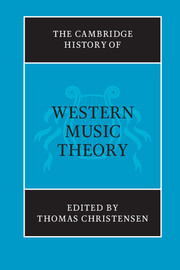Book contents
- Frontmatter
- Introduction
- PART I DISCIPLINING MUSIC THEORY
- PART II SPECULATIVE TRADITIONS
- PART III REGULATIVE TRADITIONS
- A Mapping tonal spaces
- B Compositional Theory
- C Time
- D Tonality
- 23 Tonality
- 24 Rameau and eighteenth-century harmonic theory
- 25 Nineteenth-century harmonic theory: the Austro-German legacy
- 26 Heinrich Schenker
- PART IV DESCRIPTIVE TRADITIONS
- Index of authors
- Index of subjects
- References
23 - Tonality
from D - Tonality
Published online by Cambridge University Press: 28 March 2008
- Frontmatter
- Introduction
- PART I DISCIPLINING MUSIC THEORY
- PART II SPECULATIVE TRADITIONS
- PART III REGULATIVE TRADITIONS
- A Mapping tonal spaces
- B Compositional Theory
- C Time
- D Tonality
- 23 Tonality
- 24 Rameau and eighteenth-century harmonic theory
- 25 Nineteenth-century harmonic theory: the Austro-German legacy
- 26 Heinrich Schenker
- PART IV DESCRIPTIVE TRADITIONS
- Index of authors
- Index of subjects
- References
Summary
As a music-theoretical term, “tonality” was first used by Alexander Choron in 1810 to describe the arrangement of the dominant and subdominant above and below the tonic and thus to differentiate the harmonic organization of modern music (tonalité moderne) from that of earlier music (tonalité antique). One of the main conceptual categories in Western musical thought, tonality most often refers to the orientation of melodies and harmonies toward a referential (or tonic) pitch class. In the broadest possible sense, however, it refers to systematic arrangements of pitch phenomena and relations between them.
Usage
A number of musical and discursive factors have contributed to a veritable profusion of definitions for the term. To begin with, there has been considerable indecision about what musical domain the term covers: whether it applies to both Western and non-Western music, or whether, within Western musical traditions, the term can be restricted to the harmonic organization of music from the so-called common practice (1600–1910) or includes all music that evinces a basic difference between consonance and dissonance. There have also been some basic theoretical disagreements about whether its constituent musical elements are melodies or harmonies: however narrow the definition given to the term, the domain of tonal music is so enormous, diverse, and complex that one can choose almost any combination of musical phenomena and theoretical principles as the basis for discussion. In addition to these musical problems, enormous discursive difficulties have arisen from the conceptual languages used to describe tonal phenomena, theoretical vocabularies that vary dramatically according to the aesthetic and epistemological commitments of the writer.
- Type
- Chapter
- Information
- The Cambridge History of Western Music Theory , pp. 726 - 752Publisher: Cambridge University PressPrint publication year: 2002
References
- 54
- Cited by

